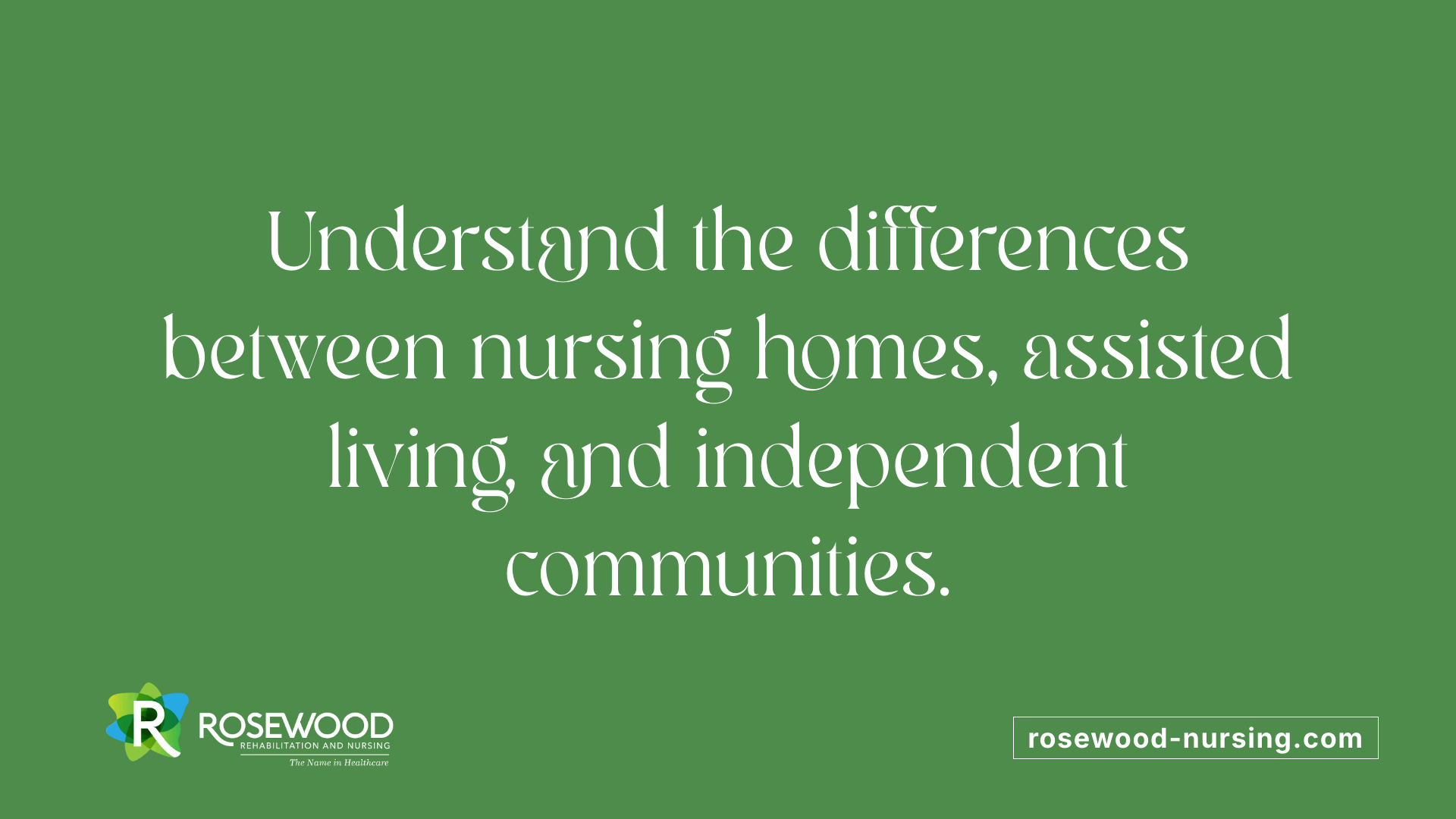How to Navigate Financial Options for Long-Term Care
April 25, 2025
Understanding and Planning for Long-Term Care Expenses

The Growing Importance of Long-Term Care Planning
As the population ages and life expectancy increases, the demand for long-term care services also rises. With approximately 70% of individuals over age 65 requiring some form of long-term care during their lifetime, the challenge of addressing these needs becomes more pressing. Navigating financial options for long-term care is crucial for minimizing costs, preserving family assets, and ensuring quality care. This guide aims to equip you with the knowledge to plan effectively for long-term care needs.
Funding Sources for Long-Term Care

Who pays for long-term care for seniors?
Long-term care for seniors is funded through a mix of various sources, depending on individual financial situations, care needs, and eligibility. Many older adults use their personal funds, including savings, pension income, investment returns, or money gained from selling a home. These out-of-pocket payments often cover services like adult day care, home health aides, and assisted living.
On the public side, Medicaid plays a vital role as the largest payer for long-term care. It is a joint federal and state program that assists low-income individuals with costs of nursing home care and some home and community-based services. Eligibility requires meeting specific income and asset limits, and states have different rules and programs.
Private insurance options are also available. Long-term care insurance policies, when purchased early, can significantly reduce out-of-pocket costs by covering services in different settings, including homes, assisted living, and nursing facilities. Some seniors also rely on hybrid policies that combine life insurance or annuities with long-term care benefits.
Additional avenues include private financing strategies such as reverse mortgages, which convert home equity into cash to cover care expenses, and trusts or life insurance policies that can be sold or borrowed against to fund care. Veterans and some federal programs may offer specific benefits tailored to their circumstances.
Medicare, contrary to common belief, generally covers short-term skilled care post-hospital stay but does not provide coverage for custodial or long-term care, making personal and public financial planning essential for those needing extended assistance.
In summary, paying for long-term care involves a diverse set of options that require careful planning to ensure access to necessary services without depleting assets prematurely.
Exploring Long-Term Care Facilities

What are the three main types of long-term care facilities?
Understanding the different long-term care options is essential for making informed decisions about aging and health needs. The three primary types of facilities are nursing homes, assisted living, and independent living communities.
Nursing homes, also known as skilled nursing facilities, offer round-the-clock medical care and supervision. They are designed for individuals with complex health issues requiring ongoing medical attention, rehabilitation services, and assistance with daily activities.
Assisted living facilities provide a supportive environment for those who need help with routines like bathing, dressing, and managing medications. They do not typically offer intensive medical services but focus on personal care and social engagement.
Independent living communities, often called senior apartments, cater to seniors who are healthy and wish to maintain their independence. These communities may offer access to services like transportation, dining, and some assistance, allowing residents to enjoy a maintenance-free lifestyle.
| Facility Type | Level of Care | Ideal For | Access to Medical Services |
|---|---|---|---|
| Nursing Homes | Full-time skilled nursing | Individuals with significant medical needs | 24/7 skilled care, rehabilitation, medical supervision |
| Assisted Living | Moderate personal care | Seniors needing help with daily activities | Basic health monitoring, medication management |
| Independent Living | Minimal or no assistance | Healthy seniors seeking independence | Usually limited, with some optional health services |
Choosing the right facility depends on the individual's health status, desired level of independence, and specific care needs. Consulting with healthcare professionals and visiting facilities can provide better insight for making the best choice.
Understanding Long-Term Care Insurance

What is long-term care insurance?
Long-term care insurance is a financial product that helps cover the costs associated with assistance for individuals with chronic illnesses or disabilities who cannot perform activities of daily living (ADLs), such as bathing, dressing, eating, or transferring. It can pay for various types of care, including in-home services, assisted living facilities, or nursing homes, depending on the policy. Policies vary widely in terms of benefits, premiums, and coverage options, and they often require careful planning around benefit amounts, duration, and waiting periods.
Long-term care insurance is designed to protect personal savings and assets, especially since government programs like Medicare typically do not cover most long-term care expenses. Purchasing such insurance early, usually in one's 50s or 60s, can help secure more affordable premiums and comprehensive coverage tailored to individual needs.
Benefits and drawbacks
Benefits:
- Provides financial protection against high long-term care costs.
- Can cover a broad range of services, including home care, assisted living, and nursing homes.
- Often includes features like inflation protection, customizing benefit periods and amounts.
- Helps preserve savings, allowing individuals to maintain their quality of life.
Drawbacks:
- Premiums can be costly, especially for comprehensive coverage.
- Policies may increase premiums over time, leading to affordability issues.
- Some policies have limited benefits, exclusions, or waiting periods.
- Market availability has declined, with fewer insurers offering new policies and some exiting the market.
Types of policies
| Type of Policy | Description | Pros | Cons |
|---|---|---|---|
| Standalone LTC Insurance | Policies solely dedicated to covering long-term care costs | Customizable coverage, inflation protection | Premiums can be high, rate increases possible |
| Hybrid Life Insurance + LTC | Combines life insurance with long-term care benefits | Dual purpose, cash value, guaranteed premiums | Generally more expensive, benefits might reduce death payout |
| Annuities with LTC Benefits | Annuity contracts with added long-term care provisions | Flexible payouts, tax advantages | Complex, requires significant upfront investment |
Choosing the right plan
Selecting suitable long-term care insurance involves assessing your health, financial situation, and care preferences. Consider the following:
- Coverage Adequacy: Ensure the plan covers the types of care you may need.
- Cost: Compare premiums and evaluate whether they are sustainable over time.
- Benefit Period & Amount: Determine how long and how much coverage will be necessary.
- Inflation Protection: Opt for policies that increase benefits over time.
- Exclusions & Limitations: Review policy details thoroughly.
Consulting with a financial planner or insurance expert can help tailor the best plan for your future care needs. Starting early, ideally between ages 50 and 55, allows for lower premiums and better coverage options.
How does long-term care insurance work?
In essence, long-term care insurance functions as a safety net—once you meet certain eligibility criteria, such as being unable to perform activities of daily living and having a qualifying diagnosis, the insurance begins to pay benefits. Payments can be made directly to care providers or reimbursed to policyholders, depending on the policy.
Coverage usually involves a waiting period (elimination period) before benefits commence, which can range from a few days to several months. After that, the insurer provides specified benefits, which could be a daily, weekly, or monthly payout. Policyholders should evaluate the balance between premiums, coverage limits, and potential out-of-pocket costs to create a comprehensive long-term care funding strategy.
Strategies for Paying Long-Term Care without Insurance
How can someone pay for long-term care without insurance?
Paying for long-term care without traditional insurance can be challenging but is achievable through several financial strategies. Many individuals rely on their personal savings, such as bank accounts, retirement funds, or investments, to cover care expenses. Selling assets like a home can also provide significant funds, especially if the owner is willing to downsize or move to a less costly living arrangement.
Government programs play a crucial role for those who qualify. Medicaid is the primary public assistance program that covers extensive long-term care costs for eligible low-income individuals. Eligibility depends on income and assets, which vary by state, and planning is often necessary to meet these criteria.
Other financial tools include leveraging home equity through reverse mortgages or home equity lines of credit (HELOCs). These options allow homeowners aged 62 and older to convert part of their home’s value into cash to pay for care, though they come with risks such as reducing estate value or foreclosure if not managed carefully.
Converting life insurance policies via life settlements can also be a source of funds. This process involves selling an existing life insurance policy to a third party for immediate cash, which can then be used to cover long-term care expenses.
Additional resources include health savings accounts (HSAs), which provide tax advantages for saving specifically for healthcare costs. Some individuals opt for short-term or hybrid insurance policies, which offer more flexible coverage options.
Ultimately, combining these strategies with proactive financial planning and understanding available government and private resources can effectively address long-term care costs without relying solely on traditional insurance policies.
Protecting Assets from Long-Term Care Costs
How can I protect my assets from long-term care costs?
Many individuals worry that the high expenses associated with long-term care could deplete their savings and jeopardize their estate. To prevent this, effective legal and financial planning is crucial.
One of the most reliable methods involves establishing proper legal structures, such as irrevocable trusts. These trusts can be tailored to meet Medicaid requirements, helping shield assets from spend-down rules and avoiding estate recovery efforts after death. For instance, placing a primary residence into a Medicaid-compliant Medicaid trust can prevent it from being counted when assessing eligibility.
In states like Ohio, inherited property or assets held jointly might be at risk during divorce or probate unless properly protected through legal arrangements. Using tools like specific types of trusts can help keep these assets safe, ensuring they are preserved for heirs.
Working closely with an elder law attorney or estate planning professional is highly recommended. They can guide you through creating a comprehensive plan that includes:
- Probate-avoidant equipment such as revocable and irrevocable living trusts.
- Medicaid-specific planning strategies, including income trusts and annuities.
- Proper documentation, like powers of attorney, which facilitates trusted decision-making if cognitive decline occurs.
These legal strategies not only protect assets but also provide peace of mind, knowing that your financial goals and care preferences are secured.
| Planning Tool | Purpose | Additional Details |
|---|---|---|
| Irrevocable Trust | Shield assets from Medicaid spend-down | Assets placed here are not accessible to Medicaid for eligibility calculation |
| Living Trust | Probate avoidance and estate planning | Can be revocable or irrevocable, depending on needs |
| Power of Attorney | Ensure financial decision-making | Appoints trusted individuals to manage finances if incapacitated |
| Income & Annuity Trusts | Protect income flows and generate funds | Useful for converting assets into income streams for care costs |
In summary, proactive legal and trust planning plays a pivotal role in securing your financial future against the high costs of long-term care. Consulting with professionals experienced in elder law and estate planning can make these complex strategies more accessible and effective.
For more information on how to protect your assets from long-term care costs, search for "ways to protect assets from long-term care costs" online, where experts detail various legal tools and planning tips to help safeguard your wealth.
Planning for Nursing Home Costs
How do most Americans pay for nursing homes?
Most Americans rely on a mix of sources to cover the high costs of nursing home care. Medicaid is the primary public program that helps finance long-term nursing home stays for eligible low-income individuals, often paying for a significant portion of costs, especially in qualifying facilities. However, Medicaid typically covers only specific beds, and strict income and asset limits apply.
Medicare, on the other hand, provides limited assistance, covering short-term skilled nursing care after hospital stays but not long-term residence costs. Therefore, most families turn to private funds such as personal savings, retirement accounts, and long-term care insurance to fund ongoing expenses.
The national median cost of a private room in a nursing home can exceed $10,000 per month, making it a substantial financial challenge. To manage these expenses, many families use a combination of savings, sell assets like homes, or leverage financial products such as reverse mortgages.
Understanding these different payment sources helps in planning effectively and exploring all available options to ensure quality care without depleting the family’s financial security.
Cost considerations
The costs associated with nursing home care are significant and vary widely depending on location, type of facility, and level of care needed. In 2023, the median annual cost for a semi-private room was about $285 per day, roughly $8,700 per month, whereas private rooms can cost approximately $320 per day or more.
Costs are rising annually, influenced by inflation, staff wages, and healthcare developments. Planning for these future expenses requires examining current savings, potential insurance coverage, and eligibility for governmental programs.
Sources for payment
Funding options for nursing care include:
- Private Funds: Personal savings, pensions, investment income, and proceeds from home sales.
- Government Programs: Medicaid, which covers extensive long-term care for low-income eligible individuals; Medicare, which provides short-term skilled care; and Veterans Affairs benefits for eligible veterans.
- Private Insurance: Long-term care insurance or hybrid policies that combine life insurance with LTC benefits.
- Financial Tools: Reverse mortgages and annuities can provide additional resources.
Careful consideration of these options, ideally with professional financial guidance, can help plan a comprehensive approach to covering care costs.
Medicaid and Medicare roles
While Medicaid is the largest payer for nursing home care, it has strict eligibility rules based on income and assets, often requiring individuals to spend down savings to qualify. It covers a significant portion of the costs but generally requires the individual to qualify financially.
Medicare's role is limited to short-term skilled care following hospital stays, covering up to 100 days in a skilled nursing facility with certain restrictions. It does not support long-term residence or custodial care, which makes Medicaid and personal resources the primary means of payment for most nursing home residents.
Understanding the specific roles of these programs aids families and individuals in planning effectively. Early planning allows for strategic asset management and benefits utilization, helping secure the necessary care without undue financial strain.
| Payment Method | Typical Coverage | Limitations | Best For |
|---|---|---|---|
| Medicaid | Significant, for low-income | Strict eligibility, asset spend-down | Low-income individuals needing long-term care |
| Medicare | Short-term, post-acute care | Does not cover long-term nursing home residence | Temporary skilled nursing needs |
| Private Savings | Fully or partially | Depletes assets quickly | Those with substantial resources |
| Long-term Care Insurance | Varies, with some coverage options | Premiums can increase, limited providers | Those planning ahead financially |
| Reverse Mortgages | As a lump sum or line of credit | Risks include foreclosure, reducing estate | Homeowners 62+ seeking to fund LTC |
By understanding the nuances of each payment source, families can better tailor their long-term care financing strategy, ensuring access to quality care without compromising their financial future.
Creating a Comprehensive Long-Term Care Plan

How to plan effectively for long-term care?
Effective long-term care planning starts with developing a clear, written strategy that reflects both current and future needs. It’s important to evaluate personal health conditions, lifestyle preferences, and potential care settings, such as in-home services, assisted living, or nursing homes. Consulting with healthcare providers, financial advisors, and family members can provide valuable insights to tailor the plan.
A critical step involves exploring various ways to fund long-term care. Options include purchasing long-term care insurance or hybrid policies that combine life insurance with care benefits. Government programs like Medicaid and the Program of All-Inclusive Care for the Elderly (PACE) offer additional assistance, especially for low-income individuals. Personal savings, home equity through reverse mortgages, and other private financing methods also play a role.
Understanding the overall costs associated with different types of care—from an average of around $33 per hour for home health aides to over $5,000 monthly for assisted living—is essential. Planning ahead helps build a financial buffer and reduces stress during times of need.
Additionally, legal tools such as powers of attorney, trusts, and advance directives can ensure that wishes are respected and assets are protected. Regularly reviewing and updating the plan to reflect changes in health, financial situation, or legislation is crucial.
Early planning, ideally in one’s 50s or 60s, allows for lower insurance premiums and a wider range of options. It also ensures that both spouses or partners are prepared for the possibility of needing care, minimizing emotional and financial burdens for families.
Overall, an effective long-term care plan combines thorough assessment, financial preparation, legal safeguards, and ongoing review, providing peace of mind and financial security for aging or disabled loved ones.
Medicaid and Its Role in Long-Term Care

What are the eligibility criteria and benefits of Medicaid for long-term care?
Medicaid is a vital program that provides health coverage for low-income individuals, including substantial support for long-term care. To qualify, applicants must meet specific income and asset limits set by their states, which vary widely. Once eligible, individuals can receive coverage for nursing home care, home and community-based services, and other long-term care needs.
Medicaid’s benefits are extensive for eligible recipients. It covers costs for skilled nursing facilities, some in-home health services, and personal care aides. For many seniors, Medicaid is the primary source of financing long-term care as they deplete their savings or reach asset limits necessary to qualify.
How does Medicaid differ from Medicare?
While both programs serve health needs, Medicaid and Medicare are distinct. Medicare primarily provides short-term coverage for hospital stays and qualified medical care but offers limited support for ongoing long-term care. It covers skilled nursing care temporarily following hospitalization but does not pay for custodial or personal care services long-term.
In contrast, Medicaid is designed to cover extensive and ongoing long-term care services, especially for low-income individuals who qualify. It often pays for nursing homes and personal care at home. Eligibility and coverage rules differ considerably, making Medicaid the main safety net for many needing lifelong or extended care.
Understanding these differences helps individuals and families plan effectively to meet long-term care needs without exhausting savings or facing unexpected costs.
Private Financing Options for Long-Term Care
When planning for the high costs of long-term care, many individuals turn to private financing options to supplement public benefits and personal savings.
One popular method is utilizing home equity through reverse mortgages. These allow homeowners aged 62 or older to convert part of their home equity into cash without having to sell their home. Funds obtained can be used to cover care expenses, providing financial flexibility. However, reverse mortgages come with risks, such as impacting estate inheritance or risking foreclosure if repayment conditions are not met.
Life insurance policies can also serve as a resource for funding long-term care. Some policies include options for cash advances or riders that permit policyholders to access benefits early if they require extended care. Additionally, selling or annuity conversions of life insurance policies can generate immediate funds for care, which might be preferable to long-term policy retention for some individuals.
Another set of tools includes annuities and trusts. Annuities with long-term care riders offer a stream of income that can be used for care costs, providing flexibility and guaranteed payments. Trusts, particularly irrevocable ones, can be established to protect assets and designate funds specifically for long-term care needs, also offering potential Medicaid eligibility advantages.
Exploring these private strategies can help preserve assets and reduce dependence on government programs, but they require careful planning and consultation with financial advisors to implement effectively.
Legal Tools for Managing Long-Term Care Expenses
Importance of estate planning
Establishing a solid estate plan is essential for future long-term care management. It ensures that your assets are protected, your health wishes are known, and your loved ones are supported.
Legal instruments like wills and trusts
Legal tools such as wills and trusts help organize your estate and specify your preferences. Wills direct how assets should be distributed after death, while trusts can protect assets from probate and Medicaid clawback, and provide ongoing support for long-term care needs.
Additional legal tools
Other instruments like power of attorney and living wills enable you to designate someone to make health and financial decisions if you become unable to do so. These legal arrangements facilitate smoother management of care and finances, safeguarding your interests.
Benefits of legal planning
Proper legal planning can reduce family conflicts, ensure medical wishes are respected, and prevent assets from being depleted too quickly. Consulting with an estate planning attorney can help tailor these tools to your individual needs, providing peace of mind now and financial security later.
Government and Community Resources for Long-Term Care
What programs are available?
Numerous government and community programs support older adults needing long-term care. The federal Medicaid program is a major provider, offering medical and long-term care services for low-income individuals. In addition, the Department of Veterans Affairs provides care options for eligible veterans. The Program of All-Inclusive Care for the Elderly (PACE) operates in some states to help seniors stay at home by integrating healthcare, social services, and support.
Local community organizations, nonprofits, and state programs also offer a range of services, including adult day care, meal delivery, and home modifications. Some services are free or low-cost, often subsidized by government or charitable organizations.
How can they be accessed?
Accessing these resources generally involves qualifying based on income, health status, and specific eligibility criteria. Start by contacting your state's health department or aging services agency. The State Health Insurance Assistance Program (SHIP) provides counseling about Medicare, Medicaid, and related programs.
For veterans, reaching out to the Department of Veterans Affairs can help explore available benefits. If you are considering PACE or other community programs, eligibility is usually determined through assessments conducted by local agencies.
Preparing necessary documentation about income, assets, and health status will help streamline the process. Consulting with social workers or aging specialists can also assist in navigating and applying for these programs effectively.
The Impact of Not Planning Early for Long-Term Care
Financial and emotional consequences
Failing to plan early for long-term care can lead to severe financial strain. Many people end up spending their savings on expensive services like nursing homes and home health aides, which can quickly deplete their assets.
Emotionally, the stress and uncertainty of unpreparedness can be overwhelming for both individuals and their families. Without a solid plan, families may face difficult decisions about care options and finances, often feeling unready or unsupported amid a crisis.
Importance of early planning
Starting your long-term care planning in your 50s or 60s allows more options, lower insurance premiums, and better financial security. Early planning helps you understand potential costs, explore insurance options, and set legal safeguards, ensuring your wishes are respected.
A proactive approach, involving conversations with loved ones and consultations with financial and legal advisors, helps ease future burdens and maintains peace of mind. The goal is to build a comprehensive strategy that considers both care preferences and financial resources to protect your independence and finances in later years.
Preparing for a Secure Future
Long-term care planning is an integral aspect of financial security during retirement. With the increasing likelihood of needing such care, understanding and utilizing various financial strategies and resources is essential. By starting early and continuously reassessing plans as circumstances change, individuals can better handle future care costs, preserving their quality of life and their estate's financial health. Engaging with professionals and leveraging a mix of personal savings, government programs, and insurance products will empower you to face long-term care needs with confidence.
References
- Paying for Long-Term Care | National Institute on Aging
- Planning for Long-Term Care: Costs, Insurance, and More
- Planning for Long-Term Care - Charles Schwab
- Navigating the Maze of Long-Term Care Options - TheStreet
- Long-term care costs & options - Fidelity Investments
- A Guide to Planning Financially for Long-term Care
- Paying For Long-Term Care: Know the Options, the Challenges, and ...
- How To Pay for Long-Term Care | Private Wealth Management
- 7 Areas of Long Term Care Financial Planning - Waterlily
- How to Plan for Long-Term Care Expenses: A Guide to Financing ...
Similar articles

Caring for Seniors with Dementia in a Nursing Home Setting

How to Handle Memory Challenges in Rehabilitation

How to Make a Nursing Home Feel Like Home

How to Choose the Best Short-Term Rehabilitation Program for Your Needs

How to Make a Respite Care Stay Comfortable for a Senior Loved One

How to Recognize and Report Elder Abuse in a Nursing Home
Contact us today and experience ”The Name in Healthcare”
Where compassion, well-being, and a welcoming community converge to redefine your healthcare journey. Welcome to Rosewood, where your family becomes our family.














